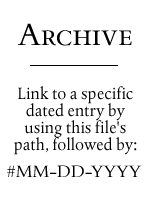|
|
|

|
 October
31, 2007: Boo And All That October
31, 2007: Boo And All That
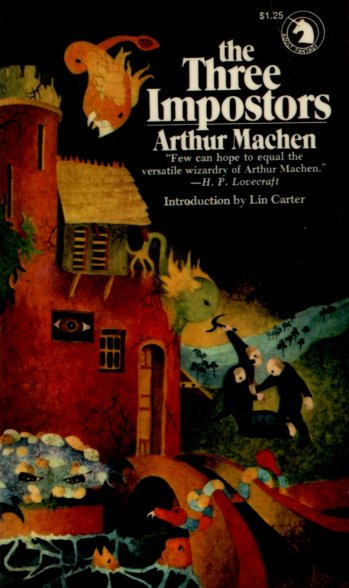 I'm
not much into Halloween, but I read a lot, and this may be a good
time to point up a little inadvertent Halloween fiction that some
of you might have missed. First to recommend is Arthur Machen's
book The Three Imposters, a loosely connected collection
of gothic horror shorts that was originally published in 1895, and
brought back to general circulation by Ballantine Books in 1972.
(See cover at left—yet another book that I casually covered
in Con*Tact plastic in 1972, never dreaming that the book would
last out the decade, nor that its cover would outlast its pages.) I'm
not much into Halloween, but I read a lot, and this may be a good
time to point up a little inadvertent Halloween fiction that some
of you might have missed. First to recommend is Arthur Machen's
book The Three Imposters, a loosely connected collection
of gothic horror shorts that was originally published in 1895, and
brought back to general circulation by Ballantine Books in 1972.
(See cover at left—yet another book that I casually covered
in Con*Tact plastic in 1972, never dreaming that the book would
last out the decade, nor that its cover would outlast its pages.)
The stories are mostly independent tales stitched together in a
loose framework. This was a mistake; the framing text is distracting
and mostly pointless—The Three Imposters is not
a novel. The stories themseves are uneven, but all are worth reading,
and do not miss "The Recluse of Bayswater," which is the
framework around the yarn most people know as "The Novel of
the White Powder." "The Adventure of the Missing Brother"
(also known as "The Novel of the Black Seal") is well-thought
of, but I don't think it's nearly as good. The whole book is in
the public domain, and you can download a PDF here.
The 1972 Ballantine edition also contained a second, shorter Machen
collection called The Red Hand, (also available as a
free PDF) which is worth reading but doesn't have anything in
the league of "The Novel of the White Powder." I won't
try to summarize any of Machen's shorts, because if you're into
Halloween at all they'll fit like an old shoe. Just read 'em.
Be of a certain age, though. I tried to read Machen originally
in seventh grade and found him tedious. By the time I was in college
I was a more patient reader and jumped from Machen to Lovecraft
(who was strongly influenced by Machen) without a stutter. Still,
it's a good thing I never tried to read Charles
Williams in grade school, or even in college. Strong
patience is called for, and if you're not an especially patient
reader, your Williams list starts and ends with Many Dimensions,
which is as close as he comes to a page-turner, and in truth not
all that close.
Many Dimensions (1931) is a loose sequel to Williams' 1930
War in Heaven, and a much better book. The dastardly Giles
Tumulty reappears, and by skullduggery manages to lay hands on the
Stone of Solomon, a little cube of weird stuff with the Tetragrammaton
written on four of its faces. Hold the Stone and will yourself to
be somewhere else, and you'll be there, without a poof or a second's
passage of time. Think yourself into the past, and you could find
yourself stuck in an endless loop. More intriguingly, you can cut
the Stone in half with a pocketknife, and both halves (which immediately
become symmetrical cubes again) will be precisely the same and precisely
as powerful. Needless to say, everybody wants the Stone, especially
the Persians who had been its guardians for over two thousand years.
The style is archaic and fluky (and the constant jumps from viewpoint
to viewpoint may be jarring until you get used to it) but Williams'
many themes are well worked out without completely destroying the
ambiguity of what the Stone actually is.
Some have said that the Stone is God, and there are times when
you could squint and perhaps think so. You have to be a little careful,
though. As often as Williams is called a "Christian writer"
(and he hung out with C. S. Lewis and J. R. R. Tolkien) there's
not much of Christianity in his novels. The God of his novels is
the God of Victorian occultism, less God as we think of Him than
an immense but impersonal force that may be invoked and wielded
like a cordless drill by a sufficiently skilled individual. The
Stone does many things, and both heals and kills over the course
of the story. (Tumulty gets his comeuppance from the Stone in a
peculiarly creepy and effective passage.) Although Williams gives
us some hints, we're ultimately left to decide what its true nature
is, and (at least in my case) ask why it entered Creation at all,
if simply to lie untouched in a Persian strongbox since before the
time of Christ, too sacred and powerful to use, touch, or even think
about.
As for the rest, well, there's Lovecraft's
whole Cthulu thang, which was fun at first but got mighty repetitive
after awhile. Sterling North's wide-ranging 1944 collection Speak
of the Devil has a certain amount of Halloweeny fun in it, and
covers a lot of fairly literary ground, from Marlowe's Faustus
through a lot of 19th century prose hobgoblinism and back to The
Devil and Daniel Webster.
That's about it for my supernatural horror collection—not
that you'll have any trouble finding more if you want it; the stuff
is still being produced by the shovelful. For my part, modern politics
is full enough of gor(e)y horror that I'd prefer not to pay for
any more, thanks. In the meantime, there's a bowl of mini-Milky
Ways near the front door and I have to keep slapping my hand to
prevent it from crawling over there on its own volition to commit
mayhem on the bowl. We'll see how many of the little things survive
the night.

|
 October
30, 2007: Gutsy Glitches, Part 3 October
30, 2007: Gutsy Glitches, Part 3
Last night I installed Kubuntu 7.10 (Gutsy Gibbon) in yet a third
partition on the new SX270, and spent a bit of time with it. Installation
went without a hitch. Even though I installed it connected to the
same Samsung 213T working at 1200 X 1600 there were no display glitches,
as there were with Ubuntu Gutsy. (See my entry for October
28, 2007.) The Adept Installer came up the first time with all
of its sources enabled, and obediently installed a great honking
pile of stuff for me.
I ran into my first glitch only when I went to set up printers.
There's no printer attached to the machine, so I attempted to install
drivers for a shared network printer. On my first two attempts,
the System Settings utility crashed when I clicked on the "Printers"
icon. On my third attempt, it worked. Nothing changed between attempts,
and I have no clue what was wrong or why it eventually righted itself.
However, on the third attempt the driver went in without a hitch
and worked perfectly.
I'm not sure if this counts as a glitch, but when I went to un-mount
a USB thumb drive, the light on the end of the thumb drive (a Cruzer
Mini) did not go out. I yanked it from the machine with a little
apprehension, even though the OS said it was no longer mounted and
could be safely removed.
I know this has nothing to do with Gutsy or even Linux, but neither
of the audio players I tried would play MP3s without going out online
to grab a codec or something.
However, I will say this for Kubuntu 7.10: It is by far and away
the smoothest Linux distro I've ever fooled with, and has given
me almost no trouble at all compared to my experiences in years
past. There are a lot of other things I still need to try, but all
the sometimes-troublesome basics are covered: Internet, local network,
printers, display. KDE is a lot more like Windows than Gnome, so
if you're coming from long Windows experience, this is definitely
the one to have.

|
 October
29, 2007: Gutsy Glitches, Part 2 October
29, 2007: Gutsy Glitches, Part 2
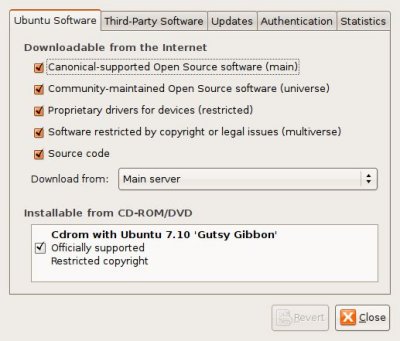 It
didn't take long to figure out why I couldn't install additional
apps into Ubuntu Gutsy Gibbon. The System | Administration |
Software Sources dialog showed that all the sources for the
software were un-checked by default and thus unavailable. (Or at
least they were un-checked in my own install, which I tried to do
using all the defaults. I don't remember any option about disabling
software sources.) It
didn't take long to figure out why I couldn't install additional
apps into Ubuntu Gutsy Gibbon. The System | Administration |
Software Sources dialog showed that all the sources for the
software were un-checked by default and thus unavailable. (Or at
least they were un-checked in my own install, which I tried to do
using all the defaults. I don't remember any option about disabling
software sources.)
After I went into the dialog and checked all the sources (the dialog
is shown at left after I was done) everything I asked for downloaded
and installed perfectly. It's still a little surreal to see all
that software come down the pipe and present itself for your use
without breaking any laws or imposing any ethical conundrums.
My biggest amazement so far is the completely seamless and incident-free
way in which Gutsy installed and configured Samba and integrated
with my local network. I took the above screenshot with the Take
Screenshot tool, which deposited it on my desktop. I then dragged
the file to a shared folder on my office system upstairs, and there
it was.
I just finished downloading the Kubuntu Gutsy Gibbon installer
image, and will attempt to install it on a different partition on
the same system later today. Nearly all of my recent Linux experience
has been using KDE, and I freely admit that I prefer it to Gnome.
There's nothing necessarily wrong with Gnome, but KDE just feels
more natural to me. I'm very interested in seeing if the installer
works the same way, and whether the Kubuntu partitioner handles
the disk as easily as the Ubuntu partitioner did. I'll let you know.

|
 October
28, 2007: Gutsy Glitches October
28, 2007: Gutsy Glitches
My new SX270 lab machine arrived the other day (I gave the old
one to my sister-in-law over the summer) so I've been digging in
and doing some research. The big deal is to install Ubuntu's new
Gutsy Gibbon release and see how it works, and especially to see
how it installs. I just finished installing it, and overall it did
a very smooth job, at least compared with every other Linux distro
I've ever installed, or tried to. However, there was one install-time
weirdness worth noting.
I first attempted the install with the SX270 connected to a Samsung
213T 21.4" display. I had most recently run Windows XP on the
machine, with the display resolution set to 1600 X 1200, which is
the native resolution of the 213T. Gutsy started out fine, but at
an early point along the way the display went into Persian rug mode
and I had to power down. I booted the install CD yet again, but
this time chose the low-resolution install from the initial menu.
The low-resolution screens were awful, and (barely) legible only
because I already had a sense for what they said. I don't know enough
about display tech to be sure what went wrong with low resolution,
but I powered the machine down again without going further.
On a hunch I took the SX270 off that bench and set it up on another
table using an old Samsung 152n 15" LCD that I had on the shelf.
The native resolution on that is 1024 X 768, and mirabile dictu!
Gutsy autodetected the correct resolution and stuck with it throughout
the install. Nothing changed but the monitor plugged into the video
connector. When connected to the 213T, it was a direct DVI connection.
When connected to the older 152n, I used a DVI-to-VGA adapter. It
looks like Gutsy isn't quite as adept at detecting DVI display hardware
during install as it is older VGA hardware.
Even more remarkably, when I shut the system down again and put
the SX270 back on the main bench and hooked it up again to the 213T,
it booted into Gutsy working at 1600 X 1200. Unless I misrecall,
a DVI monitor can tell the machine it's connected to what its native
or optimal resolution is, and that seems to be what happened here—except
that Gutsy Gibbon doesn't correctly hear the information during
install. After it's installed on a non-DVI monitor, it seems to
do just fine irrespective of what sort of monitor it's connected
to.
I don't entirely understand why Ubuntu doesn't just do what Windows
does: Install using the 640 X 480 display mode that all PC
display adapters and monitors support, at least until it's quite
sure what video hardware it has and what to do with it. Scrambling
the screen into bad neeedlepoint is a showstopper, and (worse) one
I never recall encountering while installing any version of Windows.
So they still have some work to do. I haven't done much configuring
or testing yet, and the only problem I've noticed has been with
the installer for additional applications. It looks like it's downloading
the list from somewhere, and yet when I tried to check the install
box for Abiword (or anything else not installed by default) a dialog
popped up and told me that the list of applications wasn't available.
Not sure what's wrong; Firefox accesses the Internet just fine and
the network browser sees the other systems on my local network.
On the other hand, Gutsy Gibbon has gotten farther with less trouble
than any other Linux install I've ever attempted. The only question
is why install-time display glitches still happen at all. Linux
seems to be approaching installability by non-technical people along
some sort of asymptote. Will we never actually get there?

|
 October
27, 2007: Cycolac Phone Please; Hold the Buttons October
27, 2007: Cycolac Phone Please; Hold the Buttons
 I
had a phone on the wall down in my workshop. It was a cheapie that
I had on the wall of my workshop in Scottsdale, purchased at Radio
Shack when I built the shop in 1995. A year or so ago, it fell off
the wall when I tried to answer it. And it broke. I
had a phone on the wall down in my workshop. It was a cheapie that
I had on the wall of my workshop in Scottsdale, purchased at Radio
Shack when I built the shop in 1995. A year or so ago, it fell off
the wall when I tried to answer it. And it broke.
Broke. The plastic body shattered; the receiver cracked. And anyone
over forty may feel a pang of nostalgia here: For all its expense
and inconvenience and other quirks, the Bell System knew how to
make telephones. They were indestructable. A good part of that was
solid construction, with abundant metal and thick casings. Another
part was the use of a rugged plastic called Cycolac, a thermoset
still used to make hockey sticks, which should tell you something.
All gone. I have been looking for a wall phone to replace the one
that broke. (I won't admit that I broke it. I answered it. And it
veritably leapt off the wall to its destruction.) Not only are wall
phones almost entirely extinct, phones themselves have mutated,
and they now stagger along under the weight of a sort of button
carcinoma. There used to be twelve buttons on a phone, plus the
receiver button. Now you need a long integer to count them all.
And features, yeek. I don't want voice mail. I don't want an intercom.
I don't want customized ring tones. (The telephone's inventor was
Alexander Graham Bell, not Alexander Graham Gleeble-Gleeble!)
I don't want voice announcements. I don't want a personal phone
book. (I don't mind caller ID, but I've not seen it on wall phones.)
I want a phone that I can take calls on, dial out on, and hang up
on telemarketers with. I want a phone that knows its place (on the
wall) and stays there come hell or high water. I really really
want Cycolac.
So I'm scouring eBay. Carol says I should go to the Thrift Store.
I think I need to find a good hamfest. In the meantime, the phone
plate on the wall of my workshop is empty. If you call and I don't
pick it up, that's where I'm likely to be.

|
 October
26, 2007: Seven Really Stupid Sentences October
26, 2007: Seven Really Stupid Sentences
- If you seek a pleasant
peninsula, look around you.
Nuts. I had my heart set on an isthmus.
Translation: Do it for my slimy political benefactors.
- Niles (Illinois):
Where people count!
Right next door to Morton Grove (Illinois), where people spell!
- Buffalo buffalo Buffalo
buffalo buffalo buffalo Buffalo buffalo.
I've read the
discussion and I don't buy it. The sentence is ungrammatical
without a "that." (Or a "who," if you're a member
of PETA.) Extra credit if you know where to put the "that."
Triple extra credit if you can diagram it without peeking at the
solution.
- Our mission is to
comfort the afflicted, and afflict the comfortable.
I was comfortable. You afflicted me. Now, are you going to comfort
me, or do you just need a BREAK statement?
- We're a republic,
not a democracy!
Sorry about losing that initiative.
- Please prepay in advance.
Gee, why can't I prepay after I'm done?
So...got any more?

|
 October
24, 2007: Carl and Jerry Volume 4 is Out! October
24, 2007: Carl and Jerry Volume 4 is Out!
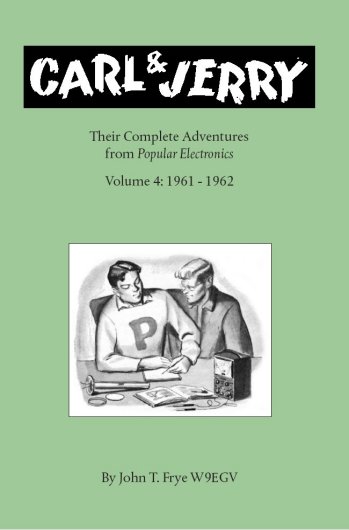 I
was out in Chicago most of the summer and didn't get a lot done
beyond what I absolutely have to do, and one of the projects that
got pushed into the deep freeze was the
fourth volume of Carl and Jerry. I had promised it originally
in August, then in September, and I didn't even start scanning until
October 8. Then I went crazy with it, and if you haven't seen much
from me in the last two weeks, that's why. I
was out in Chicago most of the summer and didn't get a lot done
beyond what I absolutely have to do, and one of the projects that
got pushed into the deep freeze was the
fourth volume of Carl and Jerry. I had promised it originally
in August, then in September, and I didn't even start scanning until
October 8. Then I went crazy with it, and if you haven't seen much
from me in the last two weeks, that's why.
I did the whole 196-page book in fifteen days, including scanning
and OCRing the magazines, cleaning up the OCR files, scanning the
illos, processing the illos, laying the whole thing out, and proofing
it. Whew.
It was great practice, particularly in image processing. In that
I was helped by Photoshop expert Pete Albrecht, whose astroimages
should not be missed. (See his
recent backyard photograph of galaxy M33, an object so pale
and low-contrast that I couldn't find it with my 8" scope,
even though M33 is the angular size of the full Moon.) It also helped
that the magazines I bought for 1961 and 1962 were in much
better shape than the crinkly, moldy messes I had for Volume 3's
1959.
There's a lot of great stuff in this volume, including several
of my all-time favorites, like "A Low Blow" and "Therry
and the Pirates." I've pinched off "A Low Blow" as
a free PDF, which you can download here.
All of the other free stories can be had at my
Carl and Jerry Web site. Look for story titles in bold in the
story index.
I'm not going to do Volume 5 in fifteen days, trust me. I intend
to start sooner and take it slower, and I expect to get that last
book in the series done on or about New Year's Day. I will continue
to lay out more free stories as time allows, as time has not for
the past couple of months.
I realize that I've been working on the Carl and Jerry project
now for an entire year, and pretty soon it will be done. Egad. What
am I gonna do with all my free time after Volume 5 goes live?
9:30 PM Mountain Time. I rarely split entries, but you gotta hear
this: I just got in from seeing a comet that brightened from magnitude
17 (far fainter than anything a small telescope will reveal to the
human eye) to magnitude 3 in less than 24 hours. That's more
than a millionfold increase in brightness. If you're in the US tonight
under clear skies, go out and look at it right now. If you
have a scope, drag it out. Comet P/Holmes makes a nice triangle
with Alpha Persei and Delta Persei. Sky & Telescope has a
simple chart that will allow you to spot it. You can see it
even from a big city, and the full Moon did it no damage.
To the naked eye it looks like a star, no fuzziness, no tail. In
my junkbox 8" scope at about 100 diameters magnification, P/Holmes
looked like Saturn sans rings and out of focus. Very yellow but
far brighter than any of the fifteen or so comets I've seen in my
life. We don't know the physics here, and the universe makes us
no promises about how long this thing will be visible, so just get
out there and see it. (Thanks to Michael Covington for sending me
the alert.)

|
 October
23, 2007: "Imply" Does Not Imply "Imply" October
23, 2007: "Imply" Does Not Imply "Imply"
I was amused to see a
recent dustup on Slashdot about the old logician's maxim, "Correlation
does not imply causation." The topic at hand was a
scientific paper about the correlation between the crime rate and
the elimination of lead from gasoline in the United States.
(PDF file.) Twenty years after the amount of lead emitted into the
environment fell radically, the violent crime rate was down 56%.
That's not completely new news, though it was nice to get a good
summary. What was amusing were all the snarky arguments in the comments
about correlation and causation.
Anytime anything like this appears, somebody jumps up and yells
"Correlation does not imply causation!" and for some reason
considers the discussion closed. Then somebody else jumps on him,
pointing out the rigor with which the correlation between the two
factors was studied, and that in this case, correlation does ferdamnsure
imply causation.
What's funny is that both are right. The problems lies in our two
different meanings of the word "imply." In logic, "imply"
means "necessarily follows from." In modern English outside
the lofty field of logic, "imply" simply means "suggests,"
which may not be a diametrically opposite meaning, but is certainly
90 degrees skewed.
Correlation certainly suggests causation, and in fact is
the great birthplace of hypotheses within the scientific process.
It doesn't prove causation in a logical sense, of course—not
in the absence of a great deal of additional data gathering, testing,
and interpretation of results.
What I can't quite figure is the ideology here (all the snarkiest
Slashdot arguments emerge from some sort of ideology) but at least
it's a done deal and the results went our way, whether we understood
what was at stake in 1973 or not. And—oh yeah—words
matter!

|
 October
20, 2007: The Mystery Crash October
20, 2007: The Mystery Crash
20 years ago yesterday, the stock market had its worst day (from
a percentage standpoint) in US history. The weirdest thing of all
is that nobody really knows what caused it. Sure, everybody's
got a theory (and everybody has something else, too) but I have
yet to read a theory that rings true to me. Certainly, the market
feeds on itself to some degree, and there was a significant speculative
bubble forming in the 6-8 months prior to the crash. I think it
was crowd chaos, and I'm content to stop there. Blaming it on a
storm in the UK is intriguing but inherently unverifiable. The
fact that nothing really bad happened afterward, and the market
regained all of its value by 1989, suggests the useful hiss of speculative
madness vanishing into the autumn air.
It's odd to think back to the people at work going into carefully
reasoned panic, talking about selling their stock and dumping their
mutual funds and so on. (I wonder how many actually did. Few, I
hope.) I remember thinking that:
- It's way too late for that now;
- Real wealth isn't easy to destroy, and the US economy is pretty
damned real; and
- Stock market crashes are effects, not causes.
I still think I was right on all three counts. I do remember thinking
in the following months that people who bought at that point would
probably do well within five years. I was certainly right about
that; in fact, there was an article in yesterday morning's Wall
Street Journal speaking of a couple of people who made a huge
amount of money buying at the end of 1987 and holding until the
runup of the 90s.
My point here is that stock market crashes are not all that important
if government does not use them as excuses to do stupid and destriuctive
things. Against that is set the seemingly indestructable conventional
wisdom that stock market crashes cause depressions. I was taught
in a 200-level American history class in 1972 that the crash of
1929 caused the Great Depression. It did not, as I learned by reading
more and better accounts of the times, by genuine historians who
weren't the egomaniacal third-shelf lefty poseurs with which De
Paul University filled its liberal arts faculty in the 70s. Global
economic nationalism, which had been growing around the world since
the 1890s, caused the Depression, and in the US it was the law with
the funny name, the Smoot-Hawley Tariff, that did the real damage.
Smoot-Hawley was the single most evil piece of legislation ever
set loose upon the American people, but it was just the American
slice of a longstanding political culture that had been in the process
of destroying Europe for almost fifty years, and damned near finished
the job between 1939 and 1945. (Money supply issues, which are also
government forces and related to nationalism, contributed strongly
as well.)
The big lessons of Octobers 1929 and 1987 are this: First, securities
markets reflect economic realities, and not vise versa. Second,
protectionism is deadly. (One reason I liked Bill Clinton
is that he was a free-trader, in defiance of much or most of his
own party.) In 1929 the government did stupid things, and destroyed
the economy. In 1987 the government did basically nothing, and the
economy continued unhindered. Economic freedom is the foundation
upon which all other freedoms are built. Lose that, and almost nothing
else matters.
The markets celebrated 1987 by plunging, and thus giving us all
a discount. Buy and hold, and enjoy the October weather. It's beautiful
all the way around.

|
 October
19, 2007: Odd Lots October
19, 2007: Odd Lots
- I was doing some keyword browsing on Lulu, and happened upon
this book. I'm
not sure what it's about; it might be a novel about someone working
in a Parisian lingerie shop...but look closely at the book's list
of keywords.
- From the "What are the chances?" file: I've fixed
a dozen or so typos in the three Carl and Jerry books so far,
nearly all of them OCR errors that I didn't catch during the edit
pass. Well, yesterday a reader came up with another: The OCR software
changed an "s" to a "c" and turned the very
Carl-and-Jerry-ish word "insulation" to "inculation."
Now, I don't read in that field and had literally never seen the
word before, but if you don't know what it is, see
the Urban Dictionary. The good news is I had a new book body
file uploaded to Lulu in ten minutes flat. God bless POD publishing!
- While fooling around with an electrical design that used sandbox
power resistors as heating elements, I realized that I wasn't
an ace at calculating back from voltage and power dissipation
to resistance. A little Google work, and bang! A
calculator. The hardest work used to be the math. Now the
hardest work is digging through a milk jug for a couple of 2700
ohm, fifteen or twenty watt resistors. (Repeat to self: V Squared
over P...V Squared over P...)
- Ubuntu Gutsy Gibbon has been released. The next codename will
be Hardy Heron. A nice essay on Ubuntu's nutty namings can be
found here.
There seems to be an alphabetic progression underway (and what
is Sue Grafton going to do after she writes Z is for Zaptieh?)
so if I get a vote I'd want the one after that to be Itchy Inchworm.
- Roy Harvey sent me a Gizmodo link describing a
cordless screwdriver powered by a capacitor. I knew
this was coming. I knew it. They had to have made the Farad such
a big unit for something. The screwdriver charges in 90
seconds. (Will it screw in more than one screw before needing
a recharge?)
- Finally, still another batch of the
World's Strangest Vehicles, from Dark Roasted Blend by way
of the Make blog. Wowsers.

|
 October
17, 2007: Primordial Rant October
17, 2007: Primordial Rant
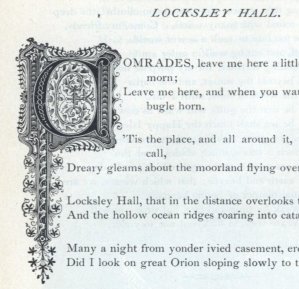 I
was pulling down books earlier today, looking for interesting page
layouts, and happened upon my 1882 edition of Tennyson's Poems
(Illustrated). The book is huge, but I had tucked a business
card into "Locksley
Hall" 20-odd years ago, and sat back to read it again.
It's always been my favorite of Tennyson's many works, and if you've
never read it, I recommend it, even if it's the only Tennyson you
ever read. It's a literary form that you may recognize: A great,
crazed, hysterical, raving Victorian rant, all done in brilliant,
rhyming fifteeners—a 15-syllable poetic meter I don't think
I remember seeing anywhere else. I
was pulling down books earlier today, looking for interesting page
layouts, and happened upon my 1882 edition of Tennyson's Poems
(Illustrated). The book is huge, but I had tucked a business
card into "Locksley
Hall" 20-odd years ago, and sat back to read it again.
It's always been my favorite of Tennyson's many works, and if you've
never read it, I recommend it, even if it's the only Tennyson you
ever read. It's a literary form that you may recognize: A great,
crazed, hysterical, raving Victorian rant, all done in brilliant,
rhyming fifteeners—a 15-syllable poetic meter I don't think
I remember seeing anywhere else.
It's also spoken in first person by a true nerd, a man who would
find himself absolutely at home in modern SF fan culture. Consider
the following portion of the poem:
Many a night from yonder
ivied casement, ere I went to rest,
Did I look on great Orion sloping slowly to the West.
Many a night I saw
the Pleiads, rising thro’ the mellow shade,
Glitter like a swarm of fire-flies tangled in a silver braid.
Here about the beach
I wander’d, nourishing a youth sublime
With the fairy tales of science, and the long result of Time;
When the centuries
behind me like a fruitful land reposed;
When I clung to all the present for the promise that it closed:
When I dipt into the
future far as human eye could see;
Saw the Vision of the world, and all the wonder that would be.—
Damn, do I get that or what?
The speaker is a soldier who recalls his youth while marching past
his childhood home, particularly his rejection by a girl named Amy,
whom he considers to have married down by not marrying him.
The guy is still half nuts about it (we're not sure how far in his
past the experience was) and he pulls out all the control rods while
insulting her and his rival:
As the husband is,
the wife is: thou art mated with a clown,
And the grossness of his nature will have weight to drag thee
down.
He will hold thee,
when his passion shall have spent its novel force,
Something better than his dog, a little dearer than his horse.
Ouch!
But what is perhaps most startling about "Locksley Hall"
is the narrator's vision (remember, this was written in 1835!) of
the future:
For I dipt into the
future, far as human eye could see,
Saw the Vision of the world, and all the wonder that would be;
Saw the heavens fill
with commerce, argosies of magic sails,
Pilots of the purple twilight, dropping down with costly bales;
Heard the heavens fill
with shouting, and there rain’d a ghastly dew
From the nations’ airy navies grappling in the central blue;
Far along the world-wide
whisper of the south-wind rushing warm,
With the standards of the peoples plunging thro’ the thunder-storm;
Till the war-drum throbb’d
no longer, and the battle-flags were furl’d
In the Parliament of man, the Federation of the world.
Verne and Wells were not the only ones with that vision, though
it took another thirty-odd years to break into mass-market novels.
The first time I read the poem, I was struck by how many good book
titles were lying around loose in there. The one I first noticed
was "the long result," and I discovered soon after that
John Brunner had used it for a novel in 1965. Brunner's The Long
Result alludes in spots to the human impulse toward colonialism,
which appears in other places in Tennyson's poem. "Pilots of
the purple twilight" has been used in more than one book and
a play. "In this march of mind" is yet another, and I
don't think anyone's used that one yet.
Anyway. I've gone on long enough, and have plenty of other things
to do today. If all you've read is modern poetry, "Locksley
Hall" may sound odd to you, but remarkably enough, poetry used
to rhyme and have regular meter. If this were still what we consider
good poetry I might even write it, but those days are long past,
alas.

|
 October
12, 2007: Preserve or Improve? October
12, 2007: Preserve or Improve?
Carl & Jerry fans have been beating my door down wanting to
know where Volume 4 is, and so I've been spending all spare cycles
on getting the book done in time for release by Halloween. I have
all the story text scanned in and OCRed, and now I'm doing the edit
pass on the text, fixing OCR errors and removing whatever formatting
inconsistences the OCR software inserted. (It paints what it sees,
and it doesn't always see precisely the same font size, column width,
etc.)
And once again I confront a conundrum I've confronted repeatedly
since I first attempted to resurrect old printed material several
years ago, with an 1875 history book called The
New Reformation: How much do you improve a text that you're
preserving? Do you preserve the errors? Do you make it easier to
read? The New Reformation was written in Victorian times
for a British audience. I agonized over whether to give it a modern
copy edit to make it more accessible to American readers in 2007.
(There are plenty of Americans who do not have any idea what a "gaol"
is.) I ended up changing British spellings to American spellings
but left the stuffy diction intact. I'm a crackshot copy editor
and could have made it a lot easier for moderns to read.
I often wonder if I should have. I just don't know, but I think
I did the right thing.
It's tougher with Carl & Jerry. The stories were never meant
to be literature, and none of us griped about the quality of the
writing—the quirkiness of the writing, in fact, is part of
the series' charm. However, it looks like Popular Electronics
in the 1954-1964 era did little or no copy editing, and in fact
little proofreading. For example, last night I spotted the following:
Carl pushed open the
door to discover Jerry speakingly slowly...
Easy call, and easy fix. Other things are a tougher call:
Both boys belonged
to the Army's Reserve Officer Training Corps, familiarly known
on the campus as "rot-see," and that is why they were in the armory.
Strictly speaking, that is why Jerry was in the armory.
Not everyone would call that an error, but to me it "sounds
funny." I fixed it. A little later, I ran across this:
"Right here," Jerry
replied, poking the little glass beads, each of which was about
three-tenths of an inch long and one-eighth inch in diameter,
with a forefinger.
Technically correct, but it sure sounds like the glass beads had
forefingers. (I left that one as-is.) Multiply that by fifteen or
twenty such decisions per story, and you'll see what I'm up against.
I had the same reaction recently while reading The Skylark of
Space as a text file on my Tablet PC. Reading it on a display
(as opposed to reading it in a book) engaged my editor's reflexes,
and I kept catching myself thinking how I could make it read a lot
better with a little polishing. Its copyrights have expired, so
no one could make a legal case if I did—but I think Doc Smith's
fans would be upset. Were I (or anyone) to take the edge off Smith's
legendary clunker writing style, something would be missing, and
it's tough to explain just what. Any competent editor could make
the pulps read better, but where (or what) would the pulps be if
they didn't sound...pulpy?
What all do we value in older writing? Tough question, especially
when you have the power to change it. Is there any use in a concept
we might call FanEd, as opposed to Fanfic? People are doing this;
see Tom Swift Lives!
for an example of a fan who is literally rewriting the old Tom Swift,
Jr. books to make them read better. He's a good writer, and it works,
though there's little left of the original in some of the rewrites,
which are more properly fanfic. Some of the later Tom Swift Jr.
books were so bad as to be called "unreadable" even by
their fans. Should they be fixed?
No answers—but it's an interesting question, and as an editor,
one I face on a regular basis.

|
 October
10, 2007: Odd Lots October
10, 2007: Odd Lots
- Having been gone most of the summer, I got seriously behind
on a lot of things, and am furiously trying to catch up. In two
days I did manage to scan all the text for the next 200-page Carl
and Jerry book, but that doesn't leave a lot of time or energy
for Contra. Bear with me.
- Carol ordered imprinted Christmas cards a month or so ago. They
arrived yesterday. Inside, in big red letters, it read: MERRY
CHRISTMAS FROM CAROL, JEFR, OBIT, and AERO. We pay them to print
seven words, and they get two wrong. (Would my bichon Obit be
welcome at a dead-dog party?)
- From Pete Albrecht comes a link to a
monitor calibration tool. Although Pete uses it because he
does some mighty sophisticated astronomical image processing,
I intuit that it may also be useful for reducing eyestrain.
- Much fuss was made awhile ago about Intel
Mash Maker, a new technology to facilitate the creation of
mashups. I stared at the entries in several aggregators where
this appeared, and slowly realized that I had no crisp idea
what a mashup is. And after reading this,
I'm still not entirely sure that I understand it any better, though
I love this quote: "CRUD operations are based on REST architectural
principles, but no formal API exists."
- People who do relatively simple things with word processing
and spreadsheets don't necessarily need the latest release of
MS Office. Here's a
nice summary of several alternatives. And looking ahead, it
appears that Linux office suite KOffice
will be made available for both Windows and Mac in the first
half of 2008. My money says this is the one to watch.
- When I saw a friend's Aibo robot dog shortly after it first
came out, my thought was: Mmmm...borderline creepy. Well, robot
toys are no longer borderline. Make sure you view the
videos. I flashed on the Sheem robot from The Witches of
Karres.
- And while we're talking robots, take a scan through Wired's
gallery of UAVs, which are basically flying robots. I particularly
like the first photo, which shows a soldier launching a dinner-plate-sized
UAV from a slingshot, just as I launched balsa wood gliders with
a rubber band on a stick in 1964. Hummers became available to
the public after awhile; will I be able to buy a WASP?

|
 October
5, 2007: October Beach October
5, 2007: October Beach

On our way back home to Colorado, and we ended our second day on
the road at Ogallala, Nebraska, just south of Lake McConaghy. We
hadn't intended to go to the lake—it's October, after all—but
it was 88° when we hit town at 4 PM. So what the hell; it's
just a few miles up the road to the south shore.
And it was beautiful; nay, it's a sort of Red State Paradise, even
a Poor Man's Hawaii. We didn't have our beach bag and thus our digital
probe thermometer, but I'm guesstimating that the water was 78°
or thereabouts. Had we had suits with us we would have been up to
our necks, but even though the beach was deserted for miles in either
direction, nudity is still illegal, and we had to content ourselves
with running the puppies up and down the sand. More than once we
had to haul Aero bodily out of the water or he would have been happily
paddling, which is at total variance with our Bichon experience:
Mr. Byte and Chewy would not willingly enter water. (QBit is much
more ambivalent about water, but he'll follow Aero if he senses
that fun is being had somewhere.) We certainly won't get any more
stateside beach time in before next summer—though we're overdue
for some sort of tropical vacation—and 2007's beach season
went out in fine, fine style.
Not much more to report. I've got a list of things as long as my
arm to do once we get home, the most important of which is Volume
4 of Carl and Jerry. And boy, I miss my own bed.

|
 October
3, 2007: Gandalf Was Here October
3, 2007: Gandalf Was Here
 I
haven't said much about it in this space, but Carol and I recently
bought a two-bedroom condo in Des Plaines, just outside Chicago,
in partnership our older nephew Brian. It was a good deal all the
way around: Brian gets a better place than he would have been able
to afford on his own right out of college, and Carol and I get a
place to stay while we're in town, which over the past 18 months
or so has been, well, a lot. I
haven't said much about it in this space, but Carol and I recently
bought a two-bedroom condo in Des Plaines, just outside Chicago,
in partnership our older nephew Brian. It was a good deal all the
way around: Brian gets a better place than he would have been able
to afford on his own right out of college, and Carol and I get a
place to stay while we're in town, which over the past 18 months
or so has been, well, a lot.
I haven't said much about the project because buying, cleaning
up, and moving into a condo is mostly boring, which doesn't mean
it hasn't been a huge amount of work. But the work is done
for the time being, and we head home tomorrow. Whew.
Down in the garage the other day, I was pulling groceries out of
the back of the 4Runner when I noticed the plumbing shown at left,
along the opposite wall. I had to think for a second, but then it
hit me: That's Gandalf's signature rune, more or less, done up in
soil pipes. Now, I don't have The Lord of the Rings with
me, but unless the arms go the other way, that's the one. (And there's
probably another rune where the arms do go the other way.)
The condo is just north of downtown Des Plaines, about 1500 feet
NNW of the venerable Choo
Choo restaurant, where your hamburgers come out of the kitchen
on flatcars behind a real Lionel Super Chief O-Gauge loco. It's
a quick 5-minute walk to the Metra station, and all the other amenties
of the downtown rehab project called Metropolitan Square.
We'll be home shortly, and I can get back to work on the fourth
volume of Carl and Jerry, and perhaps get a little SF done. With
any luck we won't even miss the fall colors. More as it happens.

|
|

